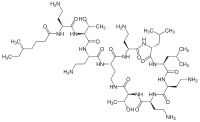
Photo from wikipedia
Objective: To investigate the antimicrobial resistance of food-borne diarrheagenic Escherichia coli (DEC) and the prevalence of mcr genes that mediates mobile colistin resistance in parts of China, 2020. Methods: For… Click to show full abstract
Objective: To investigate the antimicrobial resistance of food-borne diarrheagenic Escherichia coli (DEC) and the prevalence of mcr genes that mediates mobile colistin resistance in parts of China, 2020. Methods: For 91 DEC isolates recovered from food sources collected from Fujian province, Hebei province, Inner Mongolia Autonomous Region and Shanghai city in 2020, Vitek2 Compact biochemical identification and antimicrobial susceptibility testing platform was used for the detection of antimicrobial susceptibility testing (AST) against to 18 kinds of antimicrobial compounds belonging to 9 categories, and multi-polymerase chain reaction (mPCR) was used to detect the mcr-1-mcr-9 genes, then a further AST, whole genome sequencing (WGS) and bioinformatics analysis were platformed for these DEC isolates which were PCR positive for mcr genes. Results: Seventy in 91 isolates showed different antimicrobial resistance levels to the drugs tested with a resistance rate of 76.92%. The isolates showed the highest antimicrobial resistance rates to ampicillin (69.23%, 63/91) and trimethoprim-sulfamethoxazole (59.34%, 54/91), respectively. The multiple drug-resistant rate was 47.25% (43/91). Two mcr-1 gene and ESBL (extended-spectrum beta-lactamase) positive EAEC (enteroaggregative Escherichia coli) strains were detected. One of them was identified as serotype of O11:H6, which showed a resistance profile to 25 tested drugs referring to 10 classes, and 38 drug resistance genes were predicted by genome analysis. The other one was O16:H48 serotype, which was resistant to 21 tested drugs belonging to 7 classes and carried a new variant of mcr-1 gene (mcr-1.35). Conclusion: An overall high-level antimicrobial resistance was found among foodborne DEC isolates recovered from parts of China in 2020, and so was the MDR (multi-drug resistance) condition. MDR strains carrying multiple resistance genes such as mcr-1 gene were detected, and a new variant of mcr-1 gene was also found. It is necessary to continue with a dynamic monitoring on DEC contamination and an ongoing research into antimicrobial resistance mechanisms.
Journal Title: Zhonghua yu fang yi xue za zhi [Chinese journal of preventive medicine]
Year Published: 2023
Link to full text (if available)
Share on Social Media: Sign Up to like & get
recommendations!